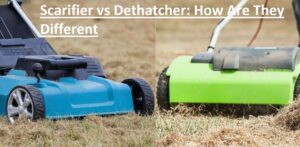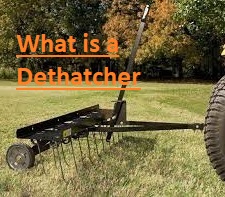Hello readers, welcome to the new post. Here, we will learn Scarifier vs. Dethatcher: How Are They Different? | Which Tool is Best For You. When maintaining lush and healthy lawns, one must understand the use of different instruments. Scarifiers and dethatchers are two standard lawn care instruments that can make a difference in the grass’s appearance. In this post, we’ll discuss the main differences between scarifiers and dethatchers and help find the best tool for lawn care. So, let’s get started with Scarifier vs Dethatcher.
What is a Scarifier?

The scarifier is a gardening instrument that slices through roots and soil to assess water food and pesticides. It comes with sharp metallic balds that cut turf to eliminate organic materials.
its working life the raking of lawn and provides free grass clipping and debris.
The lawn scrifer slices blads at 90 degrees and takes materials in an upward direction. This process helps to easily cut. Some units come with a collection box for catching thatch.
Advantages
- It is best to use for setting seed
- It is used for preventing moss, mold, and milder propagation
- it helps the chopping process that is best for removing weeds and moss.
- It loosens the soil of water and air penetration.
- Metalic blads are best for removing embedded debris
Disadvantages
- Thatch clearance can need many passes on the base of the lawn
- At the start scarifying makes lawn rough
- It can damage teh grass.
- if there is no power it will not work well
What is a Dethatcher?
The dethatcher is a tool that is used for removing thatch in the lawn. Detathcer is defined as a machine that removes loose materials from the top of a soil bed. Such as Gree Works dethatcher uses metallic tines like to the spring rake for removing loose materials.
it is thatch or organic material. it can be dead grass, clippings, and materials like moss and leaves that are not thatch. They are organic material on the thatch. So machines like LawnMaster or Sun Joe with tines syler dethatch are powered rake made for removing loose material.
Benefits of dethatchers
- The dethatching process increases water and nutrient delivery to the lawn root system
- The removal of thatch reduces the creation of moss, mildew, and fungi.
- It casues less chock and damaging lawn
- It helps to have good airflow around roots for good growth.
- it provides good and strong lawn growth
What is the Difference Between a Scarifier and a Dethatcher?

Scarifier
- it removes moderate to deep layers of thatch
- it is like a push mower with a vertically rotating cylinder and teeth-like blades
- Removes thick, dense layers of thatch effectively
- increases sunlight, airflow to the roots, water, and nutrients, stops lawns from feeling spongy, minimizes weed growth, requires fewer sessions,
- When the grass is actively growing is used
- doing the lawn before scarifying, leaving at least 25 percent of thatch behind, and avoiding scarifying newly laid or reseeded lawns
Dethatcher
- it removes light to moderate thatch
- it is like the push mower with finger-like blades
- thatch and leaves removed, and a thin layer for moisture and humidity regulation
- Enhances water and nutrient delivery, reduces moss growth, increases healthier lawn growth, stabilizes humidity and temperature, increases airflow, decreases lawn shock
- Mow the lawn before dethatching, avoid dethatching during hot, dethatch once a year and dry periods
When to dethatch your lawn
The basic rule is that the lawn must dethatched when the grass is growing fast. it means during dormant time of law dethatching should be avoided. it is based on the type of lawn you have and whether either warm season or cool season grass.
- Start through mowing lawn for decreased height and make a layer of thatch easy for dethatching
- If a layer of thatch is thicker than one inch, there is a need to do more dethatching switch scarifier.
- For maintaining a thin and required layer of thatch and needed to dethatch lawn one time in the year.
- Try to avoid dethatching during extended heat and less rainfall to reduce lawn shock
Scarifier vs Dethatcher: Which Tool Should You Purchase?
Whether it is dethatching or scarifying, make sure that the lawn has a good look. Before following any process first check the type of grass. Since both dethatching and scarifying are good for lawn maintenance, we will do the operation according to grass type. Some people use a dethatcher for spring and a scarifier for summer.
When To Scarify or Dethatch Your Lawn
The best time to scarify or dethtch lawns is in spring or fall when the grass is growing.
- If we use them in spring reduces the thatch that is made in winter. it helps the grass to grow vigorously in the spring.
- In the fall, prepare the lawn for winter. It can also avoid removing any weeds or moss that hold in summer
How To Scarify and Dethatch Your Lawn
Here are the steps on how to scarify and dethatch your lawn:
- First of all, mow lawn that reduces thatch to remove
- Blade depth should be accurately set so we remove the upper layer of thatch. If blades are deeper, they affect the grassroots.
- Do not completely scarify or dethatch at once. Work in parts and overlap each part slightly.
- The lawn must be done two times first must with a scarifier or dethatcher or make a shallow depth. The 2nd phase must do with a scarifier or dethatcher set to a deeper depth.
- After completing scarifying or dethatching rake up thatch and dispose of it.
- it is good to water the lawn after finishing.
SHOULD I SCARIFY OR DETHATCH A NEW LAWN?
There is no need to scarify or dethatch a new lawn. The new lawn needed time to make and not have thatch for some years. If scarify or dethatch before teh grass will out down and make strong roots, it will huge lawn care error and can have worse effects than good, putting out areas of grass and exposing soil
When a Dethatcher Would Be the Better Choice
The best to dethatch lawn is when it is not fast rowing and the soil is moderately moist. For cool season grass, that is early spring or early fall. dethatch in late spring done in early summer in the warm season grasses
Can you dethatch and scarify at the same time?
if you fertilize during putting the seed existing grass will grow fastly make difficult for new grass to grow. No issue with dethatch, scarify, and aerate on the same day
Read Also:
- Free Government Tablet Program by Assurance Wireless – Complete Process
- Writing Of Engineering Thesis and Dissertation: How to Ace it
- What is a 10k Resistor? Explain 10k Ohm Resistor Color Code
- Introduction to Synchronous Generator, Working, Construction, Types & Applications
- Difference between Synchronous Motor and Induction Motor
Faqs
Is scarifying better than dethatching?
If the lawn is spongy beneath your feet, then a scarifier is better to have good results than a dethatcher
Are scarifier and dethatcher the same thing?
Like dethathecer modern lawn scarifers look like push mowers. But in place of horizontal direction moving blades, uses vertical rotating cylinder and teeth like blads to pass through and remove dense dethat
Should I dethatch or scarify my lawn?
dethatching is used for removing thin layers of thatch, but scarifying is aggressive and cutting deep in the lawn to remove thick layers of thatch
What is a scarifier used for?
A lawn scarifier is a machine that removes thatch, the laser of old grass, dead moss, and debris-like leaves that compacted in your lawn over time.
What is Dethatcher used for?
it removes thatch for the lawn. A dethatcher works like a rake, towed behind a tractor, or even motorized for commercial work. A dethatcher has metallic blades or tines of the comb across the grass and pulls thatch oer surface of the lawn
Is scarifying necessary?
Scarifying is a maintenance process that removes moss or dead organic material from your grass plants called thatch layer).
Does scarifying promote growth?
Yes, scarifying can increase growth by providing air and water penetration to the roots of the grass. This helps the grass to breathe and absorb nutrients easily, which can result in healthier and high-speed growth.
What is the difference between scarifying and aeration?
Both are used for removing thatch at different degrees. Both help water, light, and nutrients to reach to soil. But scarifying helps them to pass deeper and provdies longer results in the future and helps air to move under and boost root.
When should I start scarifying?
it must be started in March to September. It is good that on this day the temperature is between 15 and 20 ° C, that is in spring and autumn
What is the process of scarifying?
Scarifying is a 2 step process. First, the scarifier is used to cut the thatch layer. 2nd, loosen the soil. It helps to increase air and water movement to the roots of the grass.
How many times can you scarify?
We can scarify lawn when required, but it is suggested to scarify no more than once in a year.
Will a scarifier remove stones?
No, a scarifier will not reduce stones. However, it can break the soil around the stones, making it simple to remove them by hand.
How deep can a scarifier go?
Some scarifiers can go as deep as 1/2 inch, while others can be 1 inch.
How deep does a scarifier do?
2-4 cm is a good high for a lawn. Before scarifying remove dead moss.
Will a scarifier pick up leaves?
No, a scarifier will not pick up leaves. But it can break the leaves and help to remove them by hand.
What is the difference between a rake and a scarifier?
A rake is a device used to smooth out the surface of a lawn. A scarifier is a device used to remove thatch and other debris from the surface of a lawn.
How much does a scarifier cost?
The prices of a scarifier are based on the size and process of the scarifier. Generally, scarifiers range in price from $100 to $500.
How often should you use a scarifier?
- Scarify lawn in spring or early autumn normally best in one year, to keep the lawn in good condition. On a new lawn, wait for about one year before scarifying, otherwise, it can damage a lawn






